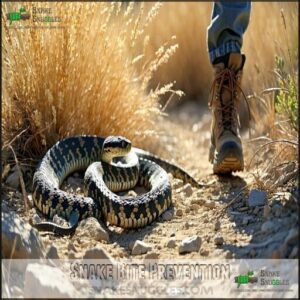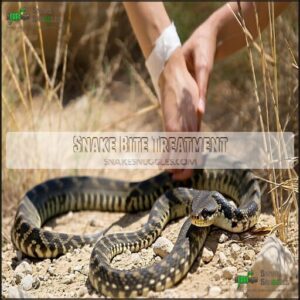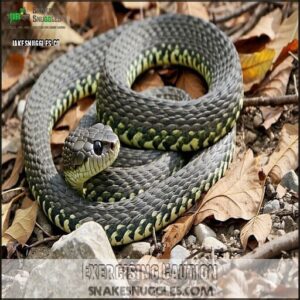This site is supported by our readers. We may earn a commission, at no cost to you, if you purchase through links.

The Red Diamond and Sidewinder rattlesnakes prefer specific terrains, like deserts and grassy regions. And let’s not forget the rare Yellow-Bellied Sea Snake that drifts along the coast.
These snakes aren’t out to get you—they bite mainly to defend themselves. Stay alert on trails, wear sturdy boots, and never try to handle them.
Understanding their behavior is the first step to safety.
Table Of Contents
- Key Takeaways
- Venomous Snakes Overview
- Snake Bite Incidence
- Geographic Distribution
- Venomous Snake Behavior
- Snake Bite Prevention
- Snake Bite Treatment
- Rattlesnake Identification
- Rattlesnake Safety Measures
- Snake Removal Services
- Frequently Asked Questions (FAQs)
- Are there any poisonous snakes in California?
- Are California king snakes poisonous to humans?
- Are Cottonmouth in California?
- What parts of California have rattlesnakes?
- How long do you have after a rattlesnake bite?
- Are northern Pacific rattlesnakes aggressive?
- Where are most rattlesnakes found in California?
- Are cottonmouth in California?
- Are snakes venomous in California?
- Are rattlesnakes venomous in California?
- Conclusion
Key Takeaways
- You’ll find venomous snakes like rattlesnakes across California, from deserts and grasslands to mountain and coastal areas.
- Rattlesnake bites can be serious, but fatalities are rare if you stay calm, avoid handling snakes, and get immediate medical help.
- Wear protective gear like snake-proof boots, stick to marked trails, and stay alert to reduce the risk of rattlesnake bites.
- Most California snakes are non-aggressive and beneficial to ecosystems, so give them space and don’t provoke them.
Venomous Snakes Overview
California is home to a variety of venomous snakes, including several species of rattlesnakes.
These snakes play a pivotal role in the ecosystem, but understanding their behavior and habitats can help you stay safe.
Western Diamondback Rattlesnake
The Western Diamondback Snake is one of California’s most iconic venomous snakes.
It thrives in dry Diamondback Habitat, like deserts and grasslands. These rattlesnakes have bold, diamond-like patterns and venom capable of serious harm.
Here’s what to know:
- Diet: Small mammals and birds.
- Venom: Potent, immobilizes prey.
- Morphology: Thick body, rattle-tipped tail.
- Conservation: Key predator balancing ecosystems.
The Western Diamondback’s venom is less potent, but the Mojave’s is far deadlier.
Northern Pacific Rattlesnake
The Northern Pacific Rattlesnake is one of California’s most adaptable venomous snakes.
Found from Santa Barbara to the northern forests, it thrives across grassy meadows, woodlands, and rocky habitats, showcasing impressive habitat variation.
Its venom potency is moderate but shouldn’t be underestimated.
You’ll recognize it by its diamond-patterned body and distinct tail rattle.
These snakes rely on camouflage to ambush prey, including rodents and birds, and typically avoid confrontation, making them fascinating yet cautious predators in California’s landscapes.
Southwestern Speckled Rattlesnake
The Southwestern Speckled Rattlesnake, one of California’s venomous snakes, is a master of disguise.
Its speckled camouflage blends perfectly with rocky terrain, making it tough to spot. With nocturnal behavior, it hunts small mammals and lizards under the cover of darkness.
Found in southeastern California, it thrives in rugged, rocky habitats where human encounters are rare. While its venom potency is mild compared to other rattlesnakes, its defensive strike is reason enough to observe from a safe distance.
- Distinctive Feature: Speckled coloration matches rocky environments, aiding in snake identification.
Mojave Rattlesnake
The Mojave Rattlesnake, one of the most dangerous venomous snakes in California, thrives in the Mojave habitat.
Its venom, a mix of neurotoxins and hemotoxins, poses serious risks.
This nocturnal rattlesnake species measures 2-4 feet and uses its rattle as a clear warning.
Known for its adaptability, its diet includes rodents and lizards.
| Feature | Details | Notes |
|---|---|---|
| Venom Type | Neurotoxic-Hemotoxic | Highly potent |
| Mojave Behavior | Nocturnal, Defensive | Avoids humans if calm |
| Typical Habitat | Mojave Desert | Dry, sandy regions |
Red Diamond Rattlesnake
The Red Diamond Rattlesnake, a stunning rattlesnake species, is known for its vivid red coloration, blending perfectly into the rocky habitats of Southern California below 5,000 feet.
This venomous snake relies on camouflage to hunt rodents and lizards.
- Habitat specifics: Coastal scrub habitats in seven southern counties.
- Venom toxicity: Potent venom requiring medical care, though bites are rare.
Sidewinder Rattlesnake
The Sidewinder Rattlesnake—California deserts’ elusive predator—is known for its unique, sidewinding motion, which lets it glide across hot sands efficiently.
These rattlesnakes thrive in Sidewinder habitat like the Mojave and Colorado deserts, blending seamlessly with shifting dunes.
With iconic horn-like eye projections, they’re camouflaged ambush hunters.
Feeding on lizards and small rodents (Sidewinder diet), their venom, though less potent, is still dangerous.
Their special Sidewinder adaptations make them fascinating yet caution-worthy among California’s venomous snakes.
| Feature | Description | Importance | Adaptation |
|---|---|---|---|
| Locomotion | Sidewinding | Traverses sand quickly | Prevents overheating |
| Eye Projections | Horn-like | Camouflage | Reduces sand obstruction |
| Diet | Lizards, rodents | Sustains survival | Masters ambush hunting |
| Venom | Mildly venomous | Protective defense | Helps subdue prey |
Yellow-Bellied Sea Snake
In California’s marine ecosystem, the yellow-bellied sea snake stands out as one of the most fascinating and dangerous poisonous snakes.
With its jet-black upper body and bright yellow underbelly, it’s easy to spot and avoid.
This highly venomous snake thrives in tropical waters, where its pelagic adaptations allow it to hunt with deadly precision.
Its neurotoxic sea snake venom makes it a predator to respect.
Rare California sightings of this ocean-dwelling hunter highlight the importance of learning more about such unique snakes.
- Quick Tip: Avoid handling or approaching snakes near coastal waters.
Snake Bite Incidence
In the context of snake bites in California, the statistics might surprise you.
With about 221 venomous snake bites annually, the risk is relatively low—just 1.41 incidents per 100,000 residents.
The majority of bites involve rattlesnakes, with 91% of hospital cases linked to their venom.
Most victims are young adults or children, and upper body bites occur twice as often as lower body bites.
Fortunately, fatal outcomes are extremely rare—only 0.2% of bites are deadly.
Staying calm, seeking snake bite treatment quickly, and learning about bite prevention can save lives.
Early antivenom access proves critical, minimizing bite severity.
Awareness of california snakes and their behavior helps reduce risk dramatically.
Following snake bite first aid guidelines is essential for improving outcomes.
Geographic Distribution
You’ll find venomous snakes across California, from dry deserts to grassy fields and coastal areas.
Each species has specific habitats where it thrives, so knowing their preferred locations can help you stay safe.
Desert Habitats
In California’s deserts, venomous snakes showcase incredible adaptations for survival.
The Sidewinder, recognized for its unique sidewinder locomotion, glides effortlessly across sandy dunes.
The Mojave rattlesnake hunts in high desert terrains, while Western Diamondbacks favor southern desert regions.
Southwestern Speckled rattlesnakes blend seamlessly using desert camouflage, and Red Diamond rattlesnakes dominate arid canyons.
Active mostly at night, these nocturnal desert snakes are essential to the desert foodwebs, conserving water and keeping ecosystems balanced.
Mountain Habitats
In California’s mountainous regions, rattlesnakes thrive thanks to unique elevation effects and ample prey abundance. These mountain snakes adapt beautifully to rugged landscapes, utilizing rocky terrain, cool springs, and vegetation.
- Great Basin Rattlesnakes prefer higher elevations, hiding under fallen logs.
- Northern Pacific Rattlesnakes stick to mountain springs and meadow edges near water sources.
- Southern Pacific Rattlesnakes love south-facing rocky slopes for sunbathing.
- Panamint Rattlesnakes rule isolated eastern ranges with sparse human activity.
- Southwestern Speckled Rattlesnakes blend into granite outcroppings for hunting and safety.
During winter hibernation, rattlesnakes retreat into deep crevices, then reemerge with warming temperatures to reclaim these diverse snake habitats in California.
Coastal Areas
You’ll find venomous snakes in California’s coastal habitats, blending into rocky shores and beach brush. The Northern Pacific Rattlesnake thrives along northern coastlines, while Southern Pacific and Red Diamond Rattlesnakes inhabit southern beaches.
Warmer days mean more movement—spring and fall heighten activity. Stay alert while hiking or exploring tide pools to avoid snake bites.
Coastal conservation supports these species, making it essential to respect their space. Need snake relocation? Call professionals.
Sea Snake ID tip: beware of Yellow-Bellied Sea Snakes occasionally spotted in Southern California, their venom effects can be serious. Always prioritize beach safety and snake safety.
Grasslands
Grasslands in California provide a perfect home for several venomous snakes, thriving in open, sunlit habitats.
These areas, shaped by grazing effects and fire ecology, host rattlesnakes expertly camouflaged among tall grasses. Stay vigilant—these snakes avoid conflict but defend themselves when startled.
- Grassland Species to Note: Great Basin Rattlesnakes, Northern Pacific Rattlesnakes, and Southern Pacific Rattlesnakes. Watch for snake bites and use identification guides when exploring their habitats to stay safe.
Woodlands
Woodland ecosystems are home to venomous snakes like Northern and Southern Pacific Rattlesnakes, blending seamlessly into dappled light and shadows.
These forest snakes navigate dense undergrowth, using camouflage tactics to ambush prey.
With prey abundance fueling their survival, this snake habitat demands vigilance. Stick to marked trails, avoiding snake bites, and remember—California’s woodland ecology rewards respect over recklessness while preserving its canopy dwellers’ natural balance.
Venomous Snake Behavior
Understanding how venomous snakes behave can help you stay safe and avoid danger.
These snakes hunt with precision, defend themselves when threatened, and sometimes use unique movements like sidewinding to navigate their environment.
Defensive Tendencies
Venomous snakes, like rattlesnakes, rely on distinct behaviors to avoid danger.
They’ll use warning signals such as tail rattling or flattening their bodies to appear larger.
If that’s ignored, threat displays escalate to an S-shaped striking posture within their strike range, ready for self-defense.
For snakes, aggression is their last resort.
Their retreat behavior often saves energy and avoids unnecessary snake encounters.
It’s nature’s way of saying, “Stay back, or else.”
Hunting Strategies
California’s venomous snakes are masters of ambush predation, combining stealth and speed in their hunting strategies.
They rely on nocturnal hunting to track rodents, birds, and lizards, striking with incredible precision.
Their venom guarantees quick immobilization, essential for survival.
Blending perfectly into their surroundings, they use camouflage to avoid predators and surprise prey.
| Hunting Strategy | Description | Purpose |
|---|---|---|
| Ambush Predation | Motionless waiting, sudden strike | Catch prey off-guard |
| Nocturnal Hunting | Active during low-light hours | Maximize stealth hunting |
| Venom Usage | Injects venom during attack | Prey immobilization |
| Camouflage | Blending into environment | Avoid detection |
| Strike Speed | Rapid, accurate lunge | Guarantee prey capture |
Unique Locomotion
The Mojave Desert Sidewinder, a rattlesnake native to California, demonstrates extraordinary snake adaptations.
Its sidewinding mechanics let it traverse deserts efficiently, gliding over soft sand with minimal heat contact. For stealth, snakes utilize rectilinear motion, hugging the ground silently.
Additionally, concertina movement helps them navigate tight spaces. Snakes also employ undulatory propulsion, curving through rugged terrain.
A fascinating trait, arboreal locomotion, enables some species to climb. These diverse snake locomotion strategies highlight incredible survival techniques in challenging habitats.
Snakes also use tongue flicking behavior to detect scents.
Snake Bite Prevention
You can reduce your chances of a snake bite by wearing protective clothing, staying on marked trails, and staying alert in areas where venomous snakes are common.
Avoid touching or handling snakes, as this is one of the most common causes of snake bites, and remember to always be cautious to minimize risks.
Protective Clothing
Your clothing can greatly enhance snake bite safety.
Start with snake-proof boots as a solid foundation, shielding your feet from bites. Add boot gaiters and tough, breathable fabric materials, like denim or canvas, to protect your legs.
Gloves are a must, offering essential hand protection when handling brush or rocky terrain. Don’t forget eye protection for an extra layer of safety if snakes strike near your face.
Consider purchasing reliable footwear for ideal protection. Dressing wisely isn’t just a precaution—it’s key to snake precautions and ensuring snake-proof safety during outdoor adventures.
Stay ready, and minimize risks effectively!
Staying on Marked Trails
Stick to marked trails—they’re your best snake bite prevention method. Staying visible helps avoid startling rattlesnakes while preserving natural habitats.
Follow these steps for snake awareness:
- Always check trail visibility ahead.
- Watch your foot placement in shaded or overgrown spots.
- Value awareness benefits: listen for rattles or movement.
- Respect habitat preservation by staying on paths.
- Maintain emergency access by avoiding unmarked routes.
Marked trails keep you safe and snakes undisturbed.
Avoiding Snake Handling
It might be tempting to get a closer look, but avoiding snake handling is critical for snake prevention and safety.
Keep a safe distance, focus on observation, and never attempt to grab, relocate, or provoke a snake.
Teach children about snake precautions, and protect pets with leashes.
Capture photos safely, and rely on professional relocation if needed.
Proper tool usage and awareness are your best snake bite safety tips for preventing unnecessary risks.
Snake Bite Treatment
If a venomous snake bites you, seek medical attention immediately to reduce the risk of serious complications.
Stay calm, note the snake’s appearance if possible, and avoid impairing blood circulation near the bite.
Seeking Medical Attention
If a venomous snake bites you, quick action matters.
Get to a hospital within an hour for urgent medical care.
Skip home remedies—they won’t help.
Keep the bite below heart level, stay calm, and limit movement to slow venom spread.
Medical professionals will evaluate symptoms and use antivenom to treat the bite effectively.
Following proper snake bite treatment guidelines reduces long-term effects, so prioritize hospitalization urgency.
Knowing these steps guarantees access to life-saving care when snake bite symptoms appear.
Documenting Snake Characteristics
Spotting a venomous snake in California? Quick thinking and observation make all the difference. Start by documenting its characteristics from a safe distance, and follow these steps:
- Take a photo from a distance: Use your phone to capture its scale patterns, rattle morphology, and color variations without risking safety.
- Focus on details: Note head shape, body size differences, and distinctive snake coloration.
A snake identification guide helps compare your observations with specific California species. Accurate details like size and venom potency aid treatment professionals and guarantee the right antivenom.
Remember to perform snake bite first aid while awaiting professional help.
Antivenom Effectiveness
When facing a venomous snake bite, antivenom is your lifeline.
These treatments are species-targeted, neutralizing venom quickly when given within the critical treatment window.
Precise dosage effects reduce toxicity, saving lives, however, some may experience allergic reactions, so expert medical care is essential.
California’s snake bite treatment centers excel in handling emergencies, ensuring survival and minimizing long-term effects.
Snake bite research continues improving antivenom types, making them more effective for patients across medical facilities, which is a critical aspect of treatment.
Rattlesnake Identification
You can identify rattlesnakes by their distinct features, like a rattle at the tip of their tail and unique blotched patterns on their scales.
Knowing these traits helps you recognize them quickly and stay safe in their presence, which is crucial for safety.
Blotched Patterns
Blotched patterns are a rattlesnake’s ultimate camouflage, helping these California snakes blend perfectly into their habitats.
Spotting these patterns can save you from an accidental snake bite. Recognize their unique designs:
- Diamond-shaped blotches showcase the Western Diamondback.
- Rusty-red markings highlight the Red Diamond Rattlesnake.
- Subtle bands and faded colors define the Mojave’s pattern mimicry.
- Speckled scales signal the Southwestern Speckled Rattlesnake.
- Region-specific textures emerge across California’s rattlesnake species.
Understanding these blotch variations and regional differences boosts your safety and awareness outdoors.
Rattle on Tail
A rattlesnake’s tail is its loud warning system.
Interlocking keratin segments create the rattle, vibrating at 25-35 Hz to produce a buzzing sound.
This distinct noise helps with snake identification, signaling danger to predators or humans.
Over time, rattle development continues with each shedding.
However, environmental factors or injuries may cause rattle loss, altering its function in snake behavior and safety awareness.
Newborn Rattlesnakes
Newborn rattlesnakes may be small, but don’t underestimate their venom. These 8-to-10-inch predators arrive with fully functional fangs and potent toxins.
Newborn rattlesnakes might look tiny, but their venom packs a punch—watch out for these stealthy, small yet dangerous hunters.
Without rattles after their first shed, they’re harder to hear. The Western Rattlesnake and others rely on instinct, no parental care, as they hunt small prey for survival.
Be alert during breeding season—snake behavior ramps up!
Similar Species
Identifying venomous snakes can be tricky with several nonvenomous species mimicking rattlesnakes.
Here are five lookalikes to watch for:
- Gopher Snakes: Imitate rattlesnakes by hissing loudly and shaking their tails.
- Kingsnakes: Resemble the Western Rattlesnake with bold banding.
- Coachwhips: Match rattlesnake length but have slender bodies.
- Hognose Snakes: Flatten their heads and bluff strike, mimicking venomous behavior.
- Water Snakes: Feature blotched patterns, confusing them with Northern Pacific Rattlesnakes.
Knowing these differences makes snake identification easier and keeps you safe outdoors.
Rattlesnake Safety Measures
You can stay safe around rattlesnakes by being cautious during their peak activity times in spring and fall.
Always watch where you step or reach, and give these snakes plenty of space to avoid dangerous encounters.
Exercising Caution
Stay safe from rattlesnakes by watching where you walk and sticking to clear trails.
Wear sturdy footwear and supervise children closely. If hiking at dusk, use a flashlight to alert others and spot snakes.
Keep a safe distance from any you see—don’t approach or touch them. Knowledge about snake bite first aid is essential for preventing serious harm.
Spring and Fall Activity
With spring’s arrival, California’s rattlesnakes emerge from hibernation to seek prey, mates, and warmth.
Watch for them when temperatures range between 70-80°F. These snakes, like the Western Rattlesnake, adjust their activity to seasons and weather.
In spring and fall, rattlesnakes are most active. Here’s what to remember:
- Spring activity peaks as they shed and hunt.
- Fall migration leads them to winter dens.
- Temperature effects influence when and where they move.
- Seasonal shedding increases encounters when snakes are vulnerable.
Distinguishing Rattlesnakes
Spotting rattlesnakes like the Western Rattlesnake, Northern Pacific Rattlesnake, or Southern Pacific Rattlesnake takes a watchful eye.
Focus on these three features: their triangular head shape, built to house venom glands, rattle morphology, a dry, clicking sound when shaken, and scale patterns, often with bold, diamond markings.
Juvenile rattlesnakes lack a fully developed rattle but show similar color variations.
- Clear warning: That distinct, arrow-shaped head is nature’s safety signal.
Mastering snake identification helps you stay alert and safe on California’s trails.
Snake Removal Services
If you spot a venomous snake on your property, it’s important to call a professional removal service right away to guarantee safety.
These experts have the tools and training to handle snakes without harming them or putting anyone at risk, which ensures safety for all involved.
Removing Poisonous Snakes
If a rattlesnake wanders onto your property, don’t panic.
Start by observing from a safe distance to identify if it’s venomous, noting the triangular head or rattle.
Humane relocation and DIY removal work best for non-aggressive snakes.
Clear tall grass, food sources, and brush piles to discourage return visits.
Use trapping methods, snake repellents, or exclusion barriers for effective snake control.
Always prioritize safety to prevent bites and guarantee snake removal success.
Professional Removal Services
When snakes invade your space, professional removal services step in with skill and care.
These experts guarantee California’s venomous snakes, like rattlesnakes, are safely removed and relocated. Count on their knowledge for:
- Humane relocation, thorough property inspections, quick emergency response, and expert snake identification.
Hiring professionals typically costs $200-$500 but brings safety and valuable prevention advice.
You can find snake removal products online if needed. Their training guarantees effective snake control while protecting both you and the snake.
It’s the smartest way to handle unwanted reptilian visitors.
Snake-Proofing Homes
After professional snake removal, bolster your home’s defenses to keep rattlesnakes at bay.
Start by sealing entryways—use weatherproof caulk for foundation cracks and install door sweeps. Yard maintenance is key: clear tall grass, debris, and overgrown shrubs.
For extra protection, consider deterrent plants like marigolds or lemongrass, which some believe discourage snakes. You can also explore options for effective snake barriers around your property.
Snake bite prevention is also aided by placing fine mesh screens on vents and adding snake-proof fencing options, like a 3-foot gravel barrier. A professional inspection confirms all precautions are airtight.
- Picture this: A tidy yard with no hiding spots, creating a safer space for your family.
Frequently Asked Questions (FAQs)
Are there any poisonous snakes in California?
Venomous vipers thrive in California, but technically, none are "poisonous."
Rattlesnakes are the state’s only venomous species, with potent bites requiring caution, not panic—just give them space, and you’ll both stay safe.
Are California king snakes poisonous to humans?
California kingsnakes aren’t poisonous to humans.
They’re non-venomous constrictors, meaning they squeeze their prey rather than using venom.
They’re harmless to people and even help control pests like rodents and other snakes, including rattlesnakes!
Are Cottonmouth in California?
You won’t find Cottonmouths in California—they’re native to the southeastern U.S.
Instead, California’s venomous snakes are rattlesnakes. Stick to safe paths and stay alert to avoid unnecessary encounters with these local reptiles.
What parts of California have rattlesnakes?
You’ll encounter rattlesnakes across much of California, especially in Southern regions, foothills, deserts, and near hiking trails.
They prefer warm, dry habitats but can appear almost anywhere, so always stay alert and cautious outdoors.
How long do you have after a rattlesnake bite?
Time is of the essence after a rattlesnake bite.
You’ve got about 6-8 hours to seek treatment before the venom causes severe damage.
Stay calm, limit movement, and get to a hospital immediately, as Time is of the essence.
Are northern Pacific rattlesnakes aggressive?
Northern Pacific rattlesnakes aren’t aggressive unless they feel threatened.
They prefer to avoid humans, using their rattle as a warning.
If provoked or cornered, they may strike, so it’s best to give them space.
Where are most rattlesnakes found in California?
Rattlesnakes are most commonly found in Southern California’s deserts, hills, and coastal areas, where warmer climates and rocky terrain suit their habits.
You’ll also see them in forests and grasslands across Northern and Central California.
Are cottonmouth in California?
Cottonmouths, also called water moccasins, aren’t native to California.
They’re found in the southeastern U.S., thriving in swamps and wetlands.
California’s venomous snakes are primarily rattlesnakes, so no worries about cottonmouths here!
Are snakes venomous in California?
Think of California’s rattlesnakes as nature’s warning system.
Some snakes here are highly venomous, like rattlesnakes, but they usually avoid humans.
Respect their space, stay alert outdoors, and you’ll stay safe from unexpected encounters.
Are rattlesnakes venomous in California?
Yes, rattlesnakes in California are venomous.
Their venom helps them hunt prey and protect themselves.
While bites can be serious, fatalities are rare.
Keep your distance, stay calm, and seek medical help if bitten.
Conclusion
Ready to explore California’s outdoors safely? Knowing about poisonous snakes in California, like rattlesnakes and the rare Yellow-Bellied Sea Snake, can help you stay protected.
These snakes usually avoid people but will strike if they feel threatened.
Stick to trails, wear proper gear, and never handle snakes.
If bitten, seek immediate medical help and note the snake’s description.
Awareness and caution go a long way in preventing bites and enjoying nature with confidence. Stay safe!




















